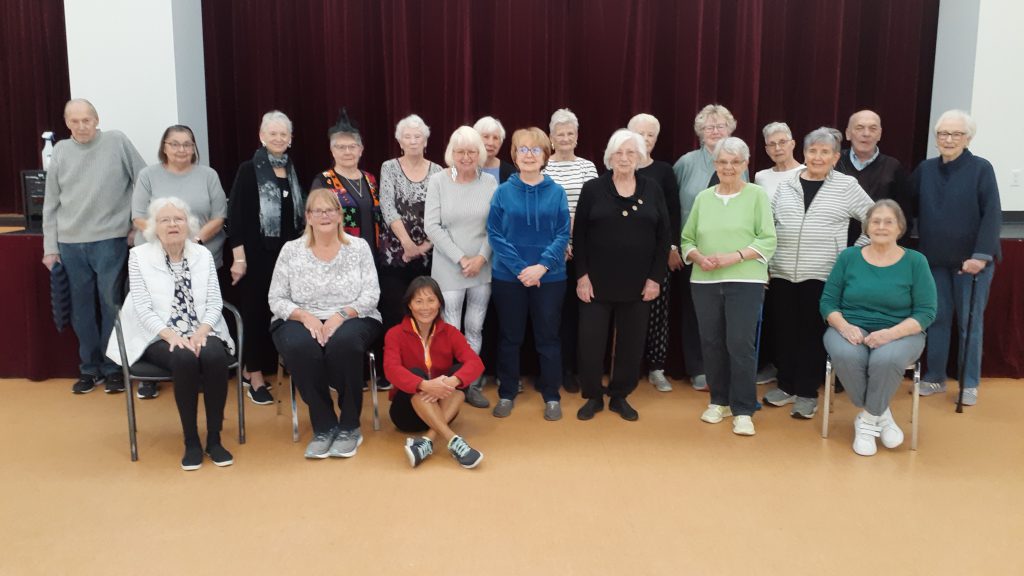
Falls can be detrimental for an older adult, causing a loss of independence and mobility, isolation, decreased mood, pain, and financial burden (Public Health Agency of Canada [PHAC], 2014, p.2). Research over the past few decades has uncovered several ways for older adults to reduce their fall risk. This includes regular vision screening, medication reviews, home safety and exercise (PHAC, 2014). However, it is well known that of these interventions, exercise is the most effective way to reduce your risk of falling (Petridou et al., 2009; PHAC, 2014).
But what kind of exercise? For fall prevention benefits, the exercise must include strength and balance, increase in difficulty, and be at least 2-3 times per week (Sherrington et al., 2011).
Debra is a regular at the Get Up & Go! activity class in Ladner which she says has greatly helped her maintain her independence and stay active. We asked her why exercise has been important to her, advice she would give to seniors wanting to start exercising, and how seniors can overcome barriers that might prevent them from exercising. Read below for her answers!
**Q: Can you share how exercise has played a role in your life as you’ve aged?**
A: Exercise has been a transformative part of my life, especially after a challenging period when I spent over six months in the hospital. Prior to being in the hospital, I led an active life and participated in activities like Osteofit (an exercise class). However, after the hospitalization, my mobility was significantly impacted, I couldn’t move or walk, which led to a considerable lifestyle change.
My journey back to mobility began with my physiotherapist suggesting a class. So, I joined the “Get Up and Go” class ten months ago and received private physiotherapy. Initially I was unable to perform even basic movements in the class, but overtime my mobility and strength improved, which help me get my independence back.
One thing I really appreciated from the class, was learning how each exercise could help me in my daily life. For instance, strengthening my hands seemed insignificant until I struggled with a can opener. After two weeks of specific hand exercises, I could use it again, which gave me more independence!
**Q: What advice would you offer to other seniors hesitant about starting an exercise routine?**
A: For seniors hesitant about starting exercise, finding a class that allows for modifications is key. Don’t be shy to speak up about your needs, and if any of the movements cause discomfort. Even a really fit senior will have days where they have a sore knee and need a modification. A good instructor will notice if something seems off or if you’re in pain. Remember, even small exercises make a significant difference in daily life.
Also know that the individuals in these classes are similar to you, facing similar challenges. You might be requesting a modification that 2-3 other people in the class need as well!
Try to embrace the social aspect; say hello and engage in conversations. You’ll find that people remember you and your name. Getting to know people makes coming to the classes more enjoyable.
Set achievable goals, and remember this will help you maintain independence! Just remember, whatever you can do, how little or how much, it will make a difference!
**Q: What are perceived barriers to physical activity for seniors, and how can they be overcome?**
A: Registration processes and finding the right class can be barriers. Trying classes with a week pass or observing a session helps in finding the perfect fit. You don’t want to accidentally sign up for a class where you are asked to go on the floor. Ask your local seniors centre if you can watch some classes before signing up, and speak to the instructor to ask them what classes they think might be a good fit for you.
Transportation is a significant issue for many seniors; having convenient, safe, and free transportation to classes makes a huge difference. In Delta, we have a seniors bus that will pick us up and bring us to our exercise classes, I think that all cities should consider having this!
I also think that we need to do a better job of educating healthcare providers about suitable programs for seniors. Having primary care providers refer their patients to exercise classes can be really motivating for people.
**Q: Any final thoughts?**
A: I have realized that when I do exercises at home, I don’t use all my muscles in the way that I do during the Get Up & Go! exercise class. And I think that is a huge benefit of attending classes, the instructors are professionals, and they make sure you use all your muscles, they can increase or decrease difficulty for you as needed and help you if you have specific needs. I also don’t get bored in classes, where-as you might get bored following the same YouTube video over and over again.
References:
Petridou, E. T., Manti, E. G., Ntinapogias, A. G., Negri, E., & Szczerbińska, K. (2009). What works better for community-dwelling older people at risk to fall? A meta-analysis of multifactorial versus physical exercise-alone interventions. Journal of aging and health, 21(5), 713-729.
Public Health Agency of Canada. (2014). Seniors’ Falls in Canada: Second Report. https://www.canada.ca/content/dam/phac-aspc/migration/phac-aspc/seniors-aines/publications/public/injury-blessure/seniors_falls-chutes_aines/assets/pdf/seniors_falls-chutes_aines-eng.pdf
Sherrington, C., Tiedemann, A., Fairhall, N., Close, J. C., & Lord, S. R. (2011). Exercise to prevent falls in older adults: an updated meta-analysis and best practice recommendations. New South Wales public health bulletin, 22(4), 78-83.